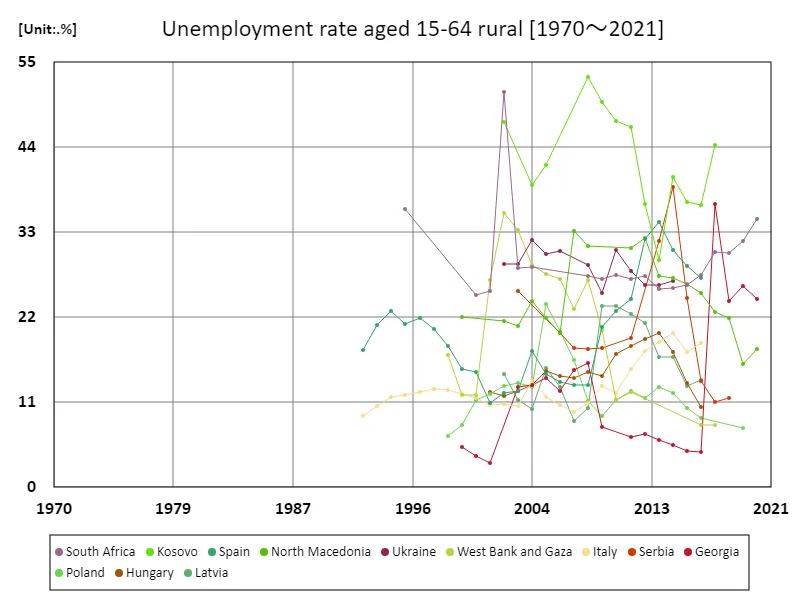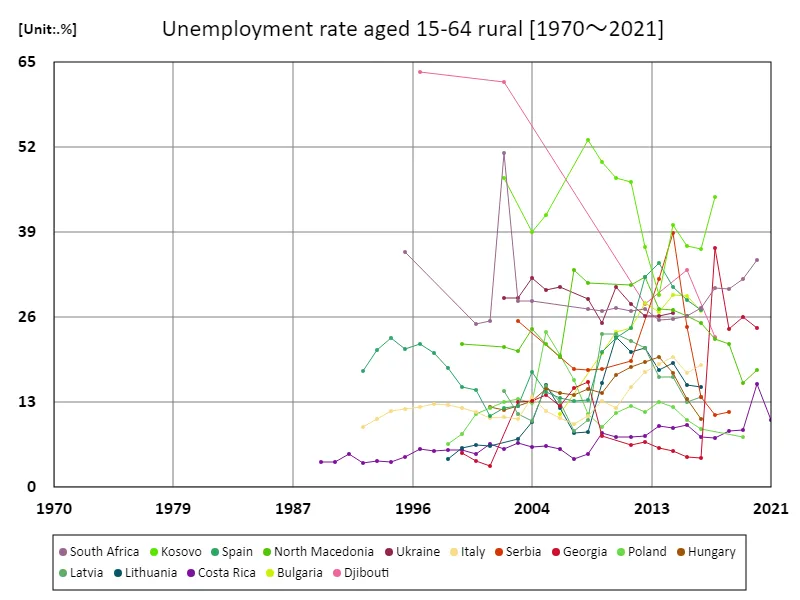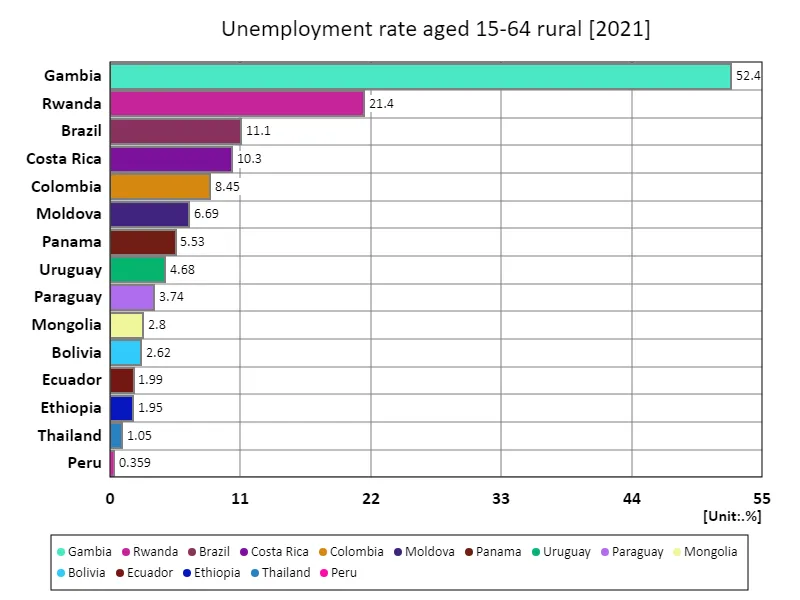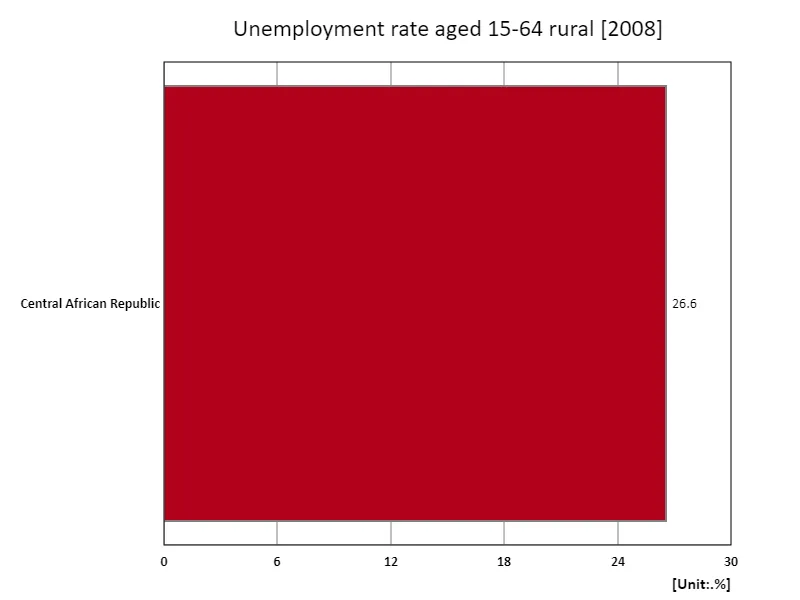- Abstract
- Unemployment rate for those aged 15-64, rural areas (as a percentage of the total rural labor force)
- Unemployment rate in rural areas aged 15-64 (as a percentage of total rural labour force) (Worldwide)
- Unemployment rate in rural areas aged 15-64 (as a percentage of total rural labour force) (Worldwide, latest year)
- Unemployment rate for people aged 15-64, rural (percentage of total rural labour force) (region, latest year)
- Reference
Abstract
In recent years, unemployment in rural South Africa among 15-64 year-olds has reached 34.7%, highlighting serious economic challenges. This high unemployment rate stems from South Africa’s unique historical background and social structure. Post-apartheid economic restructuring and inequalities in education and skills mean job opportunities are limited, especially in rural areas. Compared to urban areas, rural areas have weaker economic foundations, and a lack of infrastructure and education is hindering job creation. In addition, the agricultural sector itself is becoming less profitable, driving workers to cities, while those who remain in rural areas face limited options. Moreover, the COVID-19 pandemic has exacerbated an already fragile economic situation, with many businesses going bankrupt and employment opportunities declining further. This situation is exacerbating poverty and social inequality in South Africa, and measures to promote employment in rural areas are essential to achieving sustainable economic growth. Specifically, there is a need to improve education and skills development, invest in infrastructure, and increase agricultural productivity. This is expected to revitalize the rural economies and create jobs.
Unemployment rate for those aged 15-64, rural areas (as a percentage of the total rural labor force)
The unemployment rate for rural 15-64 year olds between 1992 and 2020 shows notable fluctuations, especially in Kosovo. Kosovo, which recorded a staggering unemployment rate of 53% in 2008, was facing a worsening employment situation in rural areas due to economic instability and political turmoil. Although the unemployment rate has fallen by 83.6% from its peak to the present, it remains at a high level, suggesting that fundamental reform of the economic structure has not progressed. During this period, employment opportunities in rural areas have been limited as industrial diversification has not progressed and the economic model remains agrarian. Furthermore, lack of education and skills is limiting employment opportunities, especially for young people, and encouraging population outmigration from rural areas to cities. This has further shrunk the rural labour force and those who remain face serious unemployment problems. Despite international support and reform programs, sustained job creation requires long-term investment. Improving infrastructure, improving education systems and diversifying industries will be key to reviving rural economies and reducing unemployment. The challenge going forward is to effectively implement these measures and create a stable employment environment.


The maximum is 53%[2008] of Kosovo, and the current value is about 83.6%
Unemployment rate in rural areas aged 15-64 (as a percentage of total rural labour force) (Worldwide)
Data from 1989 to 2021 show that unemployment among those aged 15-64 in rural Djibouti reached an extremely high level of 63.6% in 1996. This high unemployment rate is influenced by Djibouti’s economic structure, geographical conditions, and political background, with employment opportunities limited, especially in rural areas. Although agriculture is the main occupation, agricultural production has been unstable due to the effects of climate change and drought, which has led to an increase in unemployment. Currently, the unemployment rate is at 36.1% compared to its peak, but it is still high. Although there are signs of improvement, the underlying problems remain. Djibouti’s strategic geographic location means it has the potential to become a trade and logistics hub, but it needs more investment to create rural jobs. There is a need for comprehensive economic policies that include strengthening education and vocational training, improving infrastructure, and diversifying agriculture. In particular, focusing on improving the skills of young people can help ensure sustainable employment. To improve the economic situation in rural Djibouti, a long-term growth strategy, not just short-term assistance, is important. This will aim to create a stable employment environment.


The maximum is 63.6%[1996] of Djibouti, and the current value is about 36.1%
Unemployment rate in rural areas aged 15-64 (as a percentage of total rural labour force) (Worldwide, latest year)
Data for 2021 shows that rural unemployment among those aged 15-64 has reached an extremely high level of 52.4% in The Gambia, a significant deviation from the average of 9%. This shows that the rural job market is in a very tough situation. The Gambia’s high unemployment rate is due to a weak economic base, a high reliance on agriculture, and a lack of education and skills. Rural areas are typically based around labor-intensive agriculture, making them vulnerable to the effects of climate change and drought, and making it difficult to secure a stable income. Furthermore, as young people are increasingly migrating to cities and the rural workforce is shrinking, those who remain are finding the employment environment more difficult. The overall unemployment rate of 135%, taking into account overlapping statistics, shows the severity of the employment problem, especially in rural areas. Improving agricultural productivity, strengthening education programs, and nurturing local industries are essential for sustainable economic growth. In addition, with the support of the government and international organizations, we need to advance infrastructure development and job creation measures. This is expected to revitalize the rural economy and stabilize employment.


The maximum is 52.4% of Gambia, the average is 9%, and the total is 135%
Unemployment rate for people aged 15-64, rural (percentage of total rural labour force) (region, latest year)
According to 2008 data, rural unemployment among those aged 15-64 was recorded at 26.6% in the Central African Republic, which is in line with the overall average. This high unemployment rate reflects the Central African Republic’s economic instability and political turmoil, with employment opportunities particularly limited in rural areas. Although agriculture is the main livelihood, poor infrastructure and lack of education make the workforce less productive. Additionally, civil war and unstable security are also factors that hinder investment in rural areas, restricting business activity. In rural areas, many people are subsistence farmers, so some aspects are not easily reflected in official unemployment statistics, but the reality is that serious employment problems exist. To improve this situation, agricultural diversification, improved education, and investment in infrastructure are required. In addition, support is needed to revitalize local economic activity, and it is important to aim for sustainable development. This is expected to create jobs and stabilize the economy in rural areas, leading to an improvement in the lives of residents.


The maximum is 26.6% of Central African Republic, the average is 26.6%, and the total is 26.6%



Comments